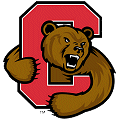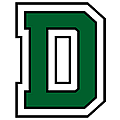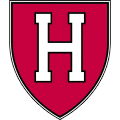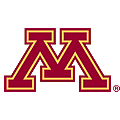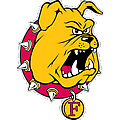Cornell
Nickname: Big Red
Location: Ithaca, NY
Founded: 1865
Conference: ECAC (Ivy League)
National Championships: 2 (1967, 1970)
Last NCAA Appearance: 2012
Last Frozen Four: 2003
Coach: Mike Schafer (19th season)
2012-13 Record: 15-16-3 (8-11-3 ECAC, 9th place)
Series: Cornell leads, 60-33-7
First Game: January 31, 1908 (Albany, NY)
Last RPI win: January 19, 2013 (Troy, NY)
Last CU win: February 22, 2013 (Ithaca, NY)
2013-14 games: November 8, 2013 (Troy, NY); February 15, 2014 (Ithaca, NY)
Key players: D Kirill Gotovets, sr.; G Andy Iles, sr.; F Dustin Mowrey, sr.; F Cole Bardreau, jr.; F Brian Ferlin, jr.; F Joel Lowry, jr.; D Jacob MacDonald, jr.; F John McCarron, jr.; D Joakim Ryan, jr.; F John Knisley, so.; D Reece Willcox, so.; F Matt Buckles, fr.; D Clint Lewis, fr.; D Patrick McCarron, fr.; D Eric Sade, fr.
Key losses: F Greg Miller, D Nick D'Agostino, F John Esposito, F Erik Axell, D Braden Birch
Previous KYE installments:
To say that Cornell had an all-around terrible season last year is actually very false. The team did, however, have a beyond dreadful six-week period from January into the middle of February that was absolutely atrocious and completely sunk the team's season.
Before falling to Maine in the Florida College Classic championship game on December 29, the Big Red had a rather Carnellian record at 7-3-2. Within those wins were home sweeps of Colorado College and the North Country teams, and a win over Michigan at Madison Square Garden. Heading into the Maine game, they'd won four games in a row, so it wasn't like there were big, flashing warning signs on the side of the road.
The Maine loss kicked off an 11-game stretch that saw Cornell go 1-10-0, an unbelievable run for a program whose streaks are practically always positive ones (and for those who claim that the streak was due to Bardreau's season-ending injury against RPI, that game was the fifth of that stretch, and he finished that game). During the streak, offense and defense were hard to come by in Ithaca. By the end of the season, the Big Red were a mind-numbing 6-5-2 at Lynah Rink and were under .500 at home coming into the last home weekend of the year against the Capital District, salvaging a winning record with a sweep.
What's more striking looking at Cornell from the current vantage point is what they did at the end of the season. Although their historic drought put them in 11th place for much of the late season run, the Big Red almost salvaged a home playoff series late with a 4-1-1 record in the last three weeks of the regular season. Having to hit the road for the playoffs, they then won three games straight and came within a goal in a double-overtime Game 3 at Quinnipiac of going back to Atlantic City anyway.
Bottom line? Just because Cornell was elsewhere for six weeks last season doesn't mean they've gone away. Far from it. Although they lose two solid NHL-draftee defensemen in D'Agostino and Birch, they gain a number of talented blue-liners this season to compliment a still-strong defensive pack.
Iles was not as strong last season as he has been in the past, but his numbers were far from being terrible. Now in his senior year, he remains one of the top netminders in the ECAC despite being largely forgotten come awards time last year in light of some of the performances of other goaltenders, most of whom are now out of the league.
Offensively, Cornell has to do better than they did last year, as too much of the scoring was bottled up in a few players. Fortunately, two guys with 10 or more goals return with Ferlin and Lowry, while classmate John McCarron netted 7 himself last year. Bardreau, it should be noted, appeared in only 13 games last season due to his injury and the World Junior Championships - expect far more offensive output from him this season.
One problem that needs to be improved in Ithaca this season is the discipline - the Big Red were the nation's most penalized team last season (although in part, taking 100 penalty minutes in Game 2 against Quinnipiac pushed them over the edge on that). Special teams needs to be improved, too: Cornell was 42nd in the nation on the power play and 47th on the penalty kill, the latter being a real problem considering the high number of penalties the team took last year.
Cornell remains a team without a great number of flaws. Provided they straighten out the special teams, this should end up being a Big Red team that the ECAC is used to seeing - one without a lot of holes that plays its style of hockey well enough to be in every game they suit up for. So if you're hoping that these are going to be a couple of pushover games for RPI, you're sadly mistaken.
Before falling to Maine in the Florida College Classic championship game on December 29, the Big Red had a rather Carnellian record at 7-3-2. Within those wins were home sweeps of Colorado College and the North Country teams, and a win over Michigan at Madison Square Garden. Heading into the Maine game, they'd won four games in a row, so it wasn't like there were big, flashing warning signs on the side of the road.
The Maine loss kicked off an 11-game stretch that saw Cornell go 1-10-0, an unbelievable run for a program whose streaks are practically always positive ones (and for those who claim that the streak was due to Bardreau's season-ending injury against RPI, that game was the fifth of that stretch, and he finished that game). During the streak, offense and defense were hard to come by in Ithaca. By the end of the season, the Big Red were a mind-numbing 6-5-2 at Lynah Rink and were under .500 at home coming into the last home weekend of the year against the Capital District, salvaging a winning record with a sweep.
What's more striking looking at Cornell from the current vantage point is what they did at the end of the season. Although their historic drought put them in 11th place for much of the late season run, the Big Red almost salvaged a home playoff series late with a 4-1-1 record in the last three weeks of the regular season. Having to hit the road for the playoffs, they then won three games straight and came within a goal in a double-overtime Game 3 at Quinnipiac of going back to Atlantic City anyway.
Bottom line? Just because Cornell was elsewhere for six weeks last season doesn't mean they've gone away. Far from it. Although they lose two solid NHL-draftee defensemen in D'Agostino and Birch, they gain a number of talented blue-liners this season to compliment a still-strong defensive pack.
Iles was not as strong last season as he has been in the past, but his numbers were far from being terrible. Now in his senior year, he remains one of the top netminders in the ECAC despite being largely forgotten come awards time last year in light of some of the performances of other goaltenders, most of whom are now out of the league.
Offensively, Cornell has to do better than they did last year, as too much of the scoring was bottled up in a few players. Fortunately, two guys with 10 or more goals return with Ferlin and Lowry, while classmate John McCarron netted 7 himself last year. Bardreau, it should be noted, appeared in only 13 games last season due to his injury and the World Junior Championships - expect far more offensive output from him this season.
One problem that needs to be improved in Ithaca this season is the discipline - the Big Red were the nation's most penalized team last season (although in part, taking 100 penalty minutes in Game 2 against Quinnipiac pushed them over the edge on that). Special teams needs to be improved, too: Cornell was 42nd in the nation on the power play and 47th on the penalty kill, the latter being a real problem considering the high number of penalties the team took last year.
Cornell remains a team without a great number of flaws. Provided they straighten out the special teams, this should end up being a Big Red team that the ECAC is used to seeing - one without a lot of holes that plays its style of hockey well enough to be in every game they suit up for. So if you're hoping that these are going to be a couple of pushover games for RPI, you're sadly mistaken.

